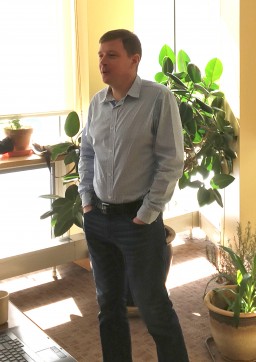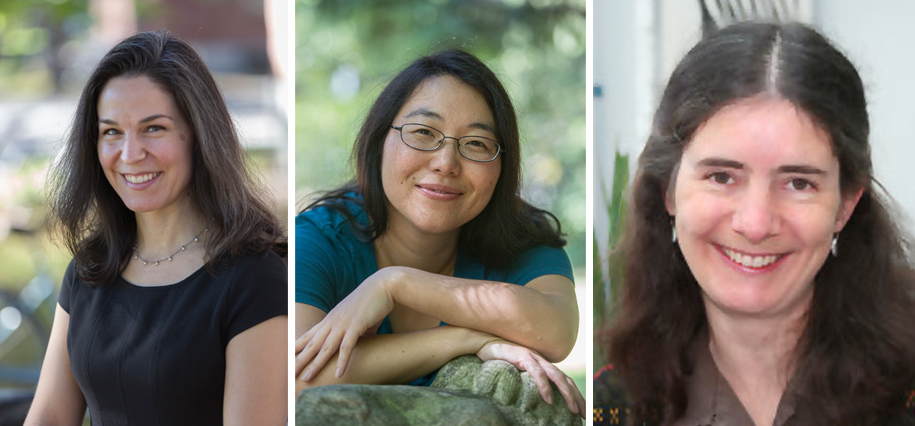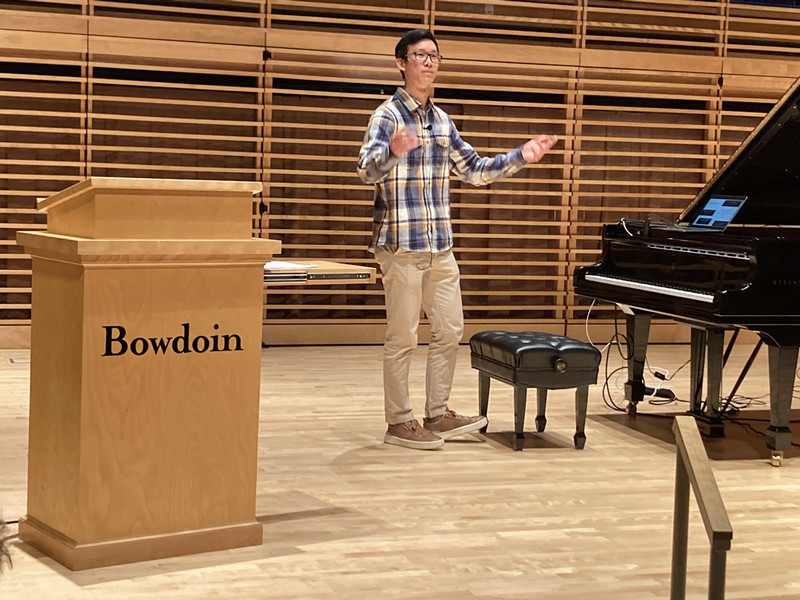The Growing Sex Appeal of Mathematics
By Tom Porter
There’s no doubt about it, mathematics is getting sexier. Take for example the recent lunchtime math lecture “Sex and the Single Statistician.”
Several dozen students crowded into Thorne Hall’s Hutchinson Room to hear Professor Thomas Pietraho talk about a mathematician’s perspective on dating and marriage.
“What we’re talking about here is a mathematical problem which parallels a common human problem–finding a suitable partner,” Pietraho told the attentive audience.
The challenge, he explained, involves trying to arrive at an optimum choice which meets certain criteria, and figuring out a strategy that gives the highest probability of success.
“We’re probably going to date a number of people in the search for Mr. or Mrs. Right,” he said, “and at some point we have to select the partner which is the best so far. The question is when do we make that choice?”

Using a tested mathematical theory, Pietraho arrived at a formula which promises the best chance of success: “If you’re going to date a lot of people–more than 16–you should start looking seriously for partners when you get to number 7. Your odds of finding true love are slightly better than one in three. I’m not trying to make any moral judgements however,” he told a clearly amused group of students, “this is math.
Take it for what it’s worth.” When asked by one student if he knew any statisticians who had successfully used this formula, Pietraho answered: “No.”
“I think it’s fun,” said math major Tara Palnitkar ’16, who attended Pietraho’s lecture. “I like the axiomatic way you can use math to prove things that you just take to be true. For example we’re often told that there are infinitely many prime numbers, but then one day you actually see the proof of it and it’s kind of crazy to see why this is true.”
Angela Dahl ’18 is also a math major. “I didn’t realize there was anything after calculus,” she said, “until I very randomly took a course of mathematical reasoning and found that it’s not all about crunching numbers and memorizing formulas.”
Dahll said math is more about thinking in a different way about how to solve problems. “Once you get past the numbers there’s a lot of very cool logic behind it,” she observed. “I think a lot of people have this perception of math as being a boring numbers-like thing, but I think it’s so much more than that.”
These students are not alone in their enthusiasm for mathematics. A subject once considered dry and boring by many has increasing undergraduate appeal. The growing emphasis on so-called STEM subjects—science, technology, engineering, and math—is reflected by the data.
At Bowdoin College for example, the number of declared math majors has grown by 250 percent over the last 15 years with 80 math majors enrolled last fall. The number of math minors has enjoyed a similar growth, rising from 14 to 38.

“This is a very significant increase in the number of majors,” said Professor Adam Levy, chair of the Mathematics Department, “and we’ve been so busy dealing with this and helping meet these students’ needs, that I haven’t had much time to think about the reasons behind it.”
However, Levy said at least some of the credit should go to popular and dynamic faculty members, many of whom are relatively new hires.
“We also changed the major requirements a few years ago,” he said, “meaning students have a shared experience in two core courses”. The end result: more math majors than most liberal arts colleges can boast, and more exposure to the subject.
And then there’s the recent STEM push by the government, to try and address a well-publicized shortage of technically qualified graduates in the workforce: “We don’t track the numbers, but anecdotally this seems to be prompting more high achieving students to go into math-relevant fields like engineering, rather than law or medicine,” Levy said.
“Statistics too is another rising subject, he said, “an area that has a variety of applications that is highly valued by many institutions.
“Math has traditionally been regarded in the US as a subject for “oddballs” or freakishly clever, nerdy types,” said Levy. “But this is changing, with a lot more students who might be described as mainstream choosing math. We still get some oddballs though, which we like. There’s nothing wrong with oddballs.”



